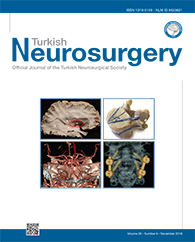2University of Health Sciences, Bakirkoy Prof Dr Mazhar Osman Training and Research Hospital for Neurology, Neurosurgery and Psychiatry, Department of Neurosurgery, Istanbul, Turkey
3Gaziosmanpasa University, Medical Faculty, Department of Otorhinolaryngology, Tokat, Turkey
4University of Health Sciences, Bakirkoy Dr. Sadi Konuk Training and Research Hospital, Department of Otorhinolaryngology, Istanbul, Turkey DOI : 10.5137/1019-5149.JTN.21588-17.1 AIM: To compare sinonasal complications after microscopic and endoscopic approaches for pituitary adenomas.
MATERIAL and METHODS: At our clinic, sinonasal complications occurred in 31 patients who underwent microscopic transsphenoidal surgery between 2007 and 2014 and in 32 patients who underwent endoscopic transsphenoidal surgery between 2014 and 2016. We statistically compared the complications observed during endoscopic sinonasal examination performed by an otorhinolaryngologist.
RESULTS: Sinonasal pathology occurred in 22 of the 31 patients (70.9%) in the microscopy group (Group 1) and 19 of the 32 (59.3%) in the endoscopy group (Group 2). Of the 31 patients in Group 1, 13 had nasal septal perforation, 13 had nasal synechiae, three had anosmia, two had hyposmia and one had saddle nose deformity. In Group 2, no patient had nasal septal perforation, whereas eight had nasal synechiae, one had anosmia, 11 had hyposmia, and 4 had infection.
CONCLUSION: There were no statistically significant differences in sinonasal complications (e.g. synechiae, anosmia, deformity, and sinusitis) between the two groups. Although the perforation rate (especially for perforations in the middle portion of the septum) was statistically greater in Group 1 than in Group 2, the hyposmia rate was statistically greater in Group 2 than in Group 1.
Keywords : Endoscopic transsphenoidal surgery, Hypophysis, Microscopic transsphenoidal surgery, Pituitary adenoma, Sinonasal complication




